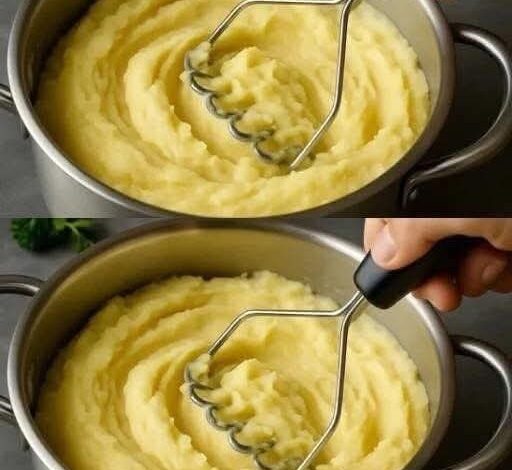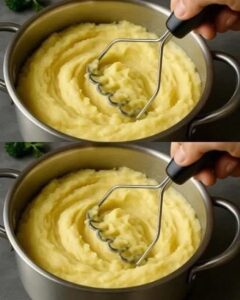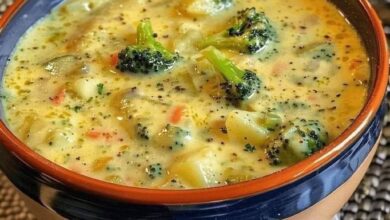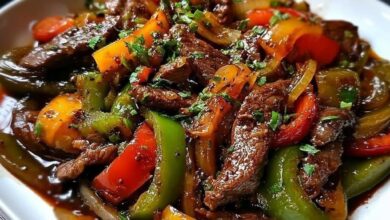A Well-Known Chef’s Tip: Stop Adding Milk or Water to Your Mashed Potatoes! Here’s the Better Way
. Why You Should Stop Adding Milk or Water

A Well-Known Chef’s Tip: Stop Adding Milk or Water to Your Mashed Potatoes! Here’s the Better Way
Mashed Potatoes

Introduction
There are few comfort foods as universally loved as mashed potatoes. Creamy, smooth, and perfectly seasoned, they have a way of completing any meal — from Thanksgiving feasts to cozy weeknight dinners. But while most people think they know how to make them, A Well-Known Chef’s Tip: Stop Adding Milk or Water to Your Mashed Potatoes! Here’s the Better Way reveals a game-changing secret that will completely transform your approach to this classic side dish.
For generations, home cooks have relied on milk or even water to loosen up their mashed potatoes. Yet, many professional chefs argue that this common method dulls flavor and affects texture. The trick to rich, indulgent mashed potatoes isn’t about more milk — it’s about using ingredients that actually enhance the flavor rather than water it down. Once you learn the better way, you’ll never go back.
This isn’t just about making your mashed potatoes taste good — it’s about unlocking the best they can be. Whether you’re feeding your family, cooking for guests, or simply treating yourself, A Well-Known Chef’s Tip: Stop Adding Milk or Water to Your Mashed Potatoes! Here’s the Better Way will help you master a timeless favorite.
Why This Recipe Works
The beauty of A Well-Known Chef’s Tip: Stop Adding Milk or Water to Your Mashed Potatoes! Here’s the Better Way lies in understanding what makes the traditional method fall short — and how simple swaps elevate both taste and texture.
1. Milk and water dilute flavor.
When you add milk or water, you’re essentially thinning out the natural potato flavor. It makes them softer but also blander. The starch molecules absorb the liquid but release flavor compounds in the process, leaving you with a watered-down taste.
2. Butter and broth enhance richness.
Butter adds luxurious creaminess and a deep, satisfying mouthfeel. Broth — whether chicken, vegetable, or even beef — infuses the potatoes with layers of savory flavor that plain water can’t match. The combination creates a perfect balance: rich yet not heavy, creamy yet still tasting like real potatoes.
3. Temperature control matters.
Warming your broth and melting your butter before adding them helps everything blend seamlessly. Cold ingredients can shock the starches, causing gluey or lumpy results.
4. Customizable texture.
With this approach, you decide how creamy or fluffy your potatoes will be. Add more broth for a softer, smoother mash, or less for a fluffier, rustic texture.
Ultimately, the reason A Well-Known Chef’s Tip: Stop Adding Milk or Water to Your Mashed Potatoes! Here’s the Better Way works so beautifully is because it restores flavor balance. The potatoes taste more like potatoes — only better.
What You’ll Need for This Recipe
Making A Well-Known Chef’s Tip: Stop Adding Milk or Water to Your Mashed Potatoes! Here’s the Better Way doesn’t require fancy tools or ingredients — just smart choices and quality basics.
Ingredients:
2 pounds russet potatoes (Yukon Gold works beautifully too)
1 cup unsalted butter, divided
1 cup warm chicken or vegetable broth, more as needed
Salt and freshly ground black pepper, to taste
Optional flavor boosters: roasted garlic, fresh herbs (thyme, rosemary, parsley), or grated Parmesan
Equipment:
Large pot
Colander
Potato masher or ricer
Saucepan (for warming broth)
Mixing spoon or spatula
Every ingredient serves a purpose. The potatoes provide the starchy base. Butter delivers velvety richness. Broth adds depth. Even the salt is critical — it brings out the natural sweetness of the potatoes while balancing the savory notes from the broth.
How To Make A Well-Known Chef’s Tip: Stop Adding Milk or Water to Your Mashed Potatoes! Here’s the Better Way
Follow these simple steps to create the creamiest, most flavorful mashed potatoes of your life.
1. Prepare the Potatoes
Peel your potatoes and cut them into even chunks about 1½ inches thick. This ensures they cook evenly. For a rustic texture, leave some skin on.
2. Boil with Salt
Place potatoes in a large pot and cover with cold water. Add a generous amount of salt — this seasons the potatoes from the inside out. Bring to a boil, then reduce heat to medium. Cook for 10–12 minutes or until a fork slides easily through a piece.
3. Drain Thoroughly
Drain the potatoes in a colander and allow them to steam off for a minute or two. Excess water is the enemy of creamy mashed potatoes, so don’t rush this step.
4. Warm the Broth and Butter
In a small saucepan, melt the butter and pour in the broth. Keep the mixture warm, not hot. This step is key to blending everything smoothly.
5. Mash to Desired Texture
Return potatoes to the pot. Using a masher or ricer, begin mashing while gradually adding the warm broth-butter mixture. Continue until the potatoes reach your ideal texture — creamy, fluffy, or somewhere in between.
6. Season and Elevate
Taste as you go. Add salt and pepper to balance the flavors. Stir in optional ingredients like roasted garlic, herbs, or cheese for a gourmet twist.
7. Serve Immediately
Spoon the mashed potatoes into a serving bowl. For a finishing touch, drizzle with a little extra melted butter or sprinkle with herbs.
Each bite of A Well-Known Chef’s Tip: Stop Adding Milk or Water to Your Mashed Potatoes! Here’s the Better Way will be pure comfort — buttery, rich, and full of flavor.
Tips + Tricks & More for Recipe Success
Even simple recipes benefit from expert guidance. To make sure A Well-Known Chef’s Tip: Stop Adding Milk or Water to Your Mashed Potatoes! Here’s the Better Way turns out perfectly every time, keep these pro secrets in mind:
Start with cold water. Boiling potatoes directly in hot water can cause uneven cooking. Cold water ensures gradual heat penetration.
Use starchy potatoes. Russets and Yukon Golds give you the fluffiest results because of their higher starch content.
Never overmix. Overworking potatoes releases excess starch, creating a gluey texture. Mash gently and stop once smooth.
Warm ingredients blend better. Cold butter or broth can shock the potatoes. Always use warmed liquids.
Customize the flavor. Try roasted garlic for depth, Parmesan for richness, or a touch of nutmeg for warmth.
Make ahead wisely. Reheat gently with a splash of warm broth to revive creaminess.
Avoid metal beaters. Electric mixers can overwork the starch. Stick with a masher or ricer for the perfect texture.
Following these pointers ensures your A Well-Known Chef’s Tip: Stop Adding Milk or Water to Your Mashed Potatoes! Here’s the Better Way stays light, flavorful, and lump-free every time.
How to Serve
The best part about A Well-Known Chef’s Tip: Stop Adding Milk or Water to Your Mashed Potatoes! Here’s the Better Way is its versatility. It pairs beautifully with nearly any main dish.
Serve them alongside:
Roast chicken or turkey for Sunday dinners.
Grilled steak or pork chops for a comforting meal.
Meatloaf or Salisbury steak for a nostalgic touch.
Sautéed vegetables for a hearty vegetarian pairing.
To keep them warm at the table, cover your serving bowl with foil or place it over a pot of simmering water (a makeshift double boiler). This method prevents the mashed potatoes from drying out before serving.
Serving Suggestions
Take A Well-Known Chef’s Tip: Stop Adding Milk or Water to Your Mashed Potatoes! Here’s the Better Way to the next level with these creative serving ideas:
Make a mashed potato bar: Offer toppings like crispy bacon, shredded cheese, chives, caramelized onions, or sour cream. Guests can customize their own bowls.
Use as a casserole base: Spread mashed potatoes in a baking dish, top with ground beef and vegetables, and bake for an easy shepherd’s pie.
Pipe them for presentation: For holidays, pipe the mashed potatoes onto a platter using a pastry bag for elegant swirls.
Add truffle oil: A drizzle of truffle oil instantly turns these potatoes into a fine-dining experience.
Top with gravy or compound butter: Both amplify the richness already built into the recipe.
However you serve them, this dish is sure to impress. Every version of A Well-Known Chef’s Tip: Stop Adding Milk or Water to Your Mashed Potatoes! Here’s the Better Way earns rave reviews.
Time, Storage, and Make-Ahead Tips
Time Required
Prep time: 10 minutes
Cook time: 15 minutes
Mash and mix: 5 minutes
Total time: About 30 minutes
Storage
Leftover A Well-Known Chef’s Tip: Stop Adding Milk or Water to Your Mashed Potatoes! Here’s the Better Way keeps beautifully for up to 3 days in the refrigerator. Store in an airtight container and reheat gently over low heat with a splash of warm broth to refresh the texture.
Freezing
You can freeze them too! Scoop into freezer-safe containers or bags, leaving space for expansion. Reheat from frozen in a covered dish at 350°F (175°C) until warm, stirring occasionally and adding broth if needed.
Make-Ahead
To save time during busy holidays, make the mashed potatoes a day in advance. Reheat them gently with extra butter and broth for fresh-made flavor.
These time-saving tips make A Well-Known Chef’s Tip: Stop Adding Milk or Water to Your Mashed Potatoes! Here’s the Better Way not just delicious but practical.
Common Mistakes to Avoid
Even the best recipes can go wrong without care. Here’s what to watch for:
Adding liquid too quickly: Always pour broth gradually while mashing to avoid a runny texture.
Skipping the drain: Water left behind after boiling can sabotage creaminess.
Cold butter: It won’t blend smoothly. Warm it slightly before mixing.
Overcooking: Mushy potatoes can become gluey once mashed. Check doneness early.
Neglecting salt: Potatoes absorb a lot of seasoning — taste throughout the process.
Keeping these simple pointers in mind ensures your A Well-Known Chef’s Tip: Stop Adding Milk or Water to Your Mashed Potatoes! Here’s the Better Way always turns out restaurant-quality.
Final Thoughts
There’s something undeniably satisfying about mastering a humble dish and turning it into something extraordinary. That’s exactly what happens when you follow A Well-Known Chef’s Tip: Stop Adding Milk or Water to Your Mashed Potatoes! Here’s the Better Way.
By replacing milk or water with butter and broth, you unlock flavors that are deeper, richer, and more comforting than ever before. You gain control over consistency, avoid the pitfalls of watery potatoes, and create a side dish that stands proudly on any table.
The next time you crave mashed potatoes — whether for a simple family meal or a grand celebration — remember this trick. A Well-Known Chef’s Tip: Stop Adding Milk or Water to Your Mashed Potatoes! Here’s the Better Way isn’t just advice; it’s the key to creamy, golden perfection in every bite.
Make it once, and you’ll understand why professional chefs swear by it — and why your family will start asking for your mashed potatoes again and again.
Here’s a fantastic extra ingredient that will take A Well-Known Chef’s Tip: Stop Adding Milk or Water to Your Mashed Potatoes! Here’s the Better Way to the next level:
Creamy Roasted Garlic
Roasted garlic adds a deep, mellow sweetness and rich aroma that blends beautifully with the butter and broth. It gives your mashed potatoes a luxurious, restaurant-quality flavor without overpowering the natural taste of the potatoes.
How to use it:
Roast a whole bulb of garlic (cut the top off, drizzle with olive oil, wrap in foil, and bake at 400°F/200°C for about 35–40 minutes).
Squeeze out the soft, golden cloves and mash them into your potatoes along with the butter and broth.
Result:
You’ll get buttery, savory mashed potatoes with a subtle roasted flavor that’s out of this world.
Chicken Bubble Biscuit Bake Casserole Recipe: A Comfort Food Classic



